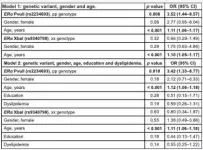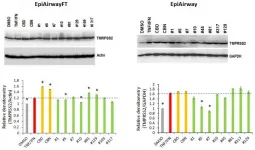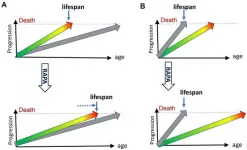(Press-News.org) Oncotarget recently published "Estrogen receptor α polymorphism is associated with dementia in a Brazilian cohort" which reported that the growth of the elderly population is a worldwide phenomenon and it is associated with chronic diseases, including dementia.
In this scenario, the present study aimed to evaluate a possible association of estrogen receptor α polymorphisms with dementia in a Brazilian cohort.
The genotyping for the ERα PvuII and XbaI polymorphisms were performed by polymerase chain reaction-restriction fragment length polymorphism.
The ERα PvuII pp genotype was associated with a higher odds ratio for dementia (OR = 3.42, 95% CI = 1.33-8.77, p = 0.01, in a model including covariates.
A linear regression model identified significant associations of the ERα PvuII genotypes with CDR scale , β = 0.26 and p = 0.001. In conclusion, estrogen receptor α PvuII polymorphism is associated with dementia in a Brazilian cohort.
"In conclusion, estrogen receptor α PvuII polymorphism is associated with dementia in a Brazilian cohort"
Dr. Valerio Garrone Barauna from The Federal University of Espirito Santo-Department of Physiological Sciences said, "One of the most striking features of the current world's demographic dynamics is the process of population aging, that is, the increase in the absolute number and percentage of elderly people in the population as a whole, which has occurred since 1950, but mainly during the 21st century."
One of the most striking features of the current world's demographic dynamics is the process of population aging, that is, the increase in the absolute number and percentage of elderly people in the population as a whole, which has occurred since 1950, but mainly during the 21st century.
In relative terms, the elderly population accounted for 5.1% of the total 1950 population, rose to 6.5% by 2020 and is expected to reach 22.6% by 2100 .
Among the chronic-degenerative conditions that afflict this "new" population, hypertension, diabetes mellitus, osteoporosis, atherosclerosis and dementia, in particular Alzheimer's disease, stand out .
The diagnosis of Alzheimer's disease and other types of dementia, which occur with severe cognitive loss, is based on the observation of clinical data.
Biochemical and genetic studies are important for identifying markers to make diagnosis more assertive, for predicting risk of disease, and/or differential diagnosis between dementias.
The Barauna Research team concluded in their Oncotarget Research Paper that this study has some limitations.
For a better statement about this polymorphism, a larger and more heterogeneous cohort would be needed.
In addition, coexisting multiple factors are important in pathogenesis changes.
The diagnostic research relationships for potential risk factors for dementia versus current clinical application should take into account both genetic and longevity biomarkers with patients.
Diagnostic and prognostic research can no longer be exclusively based on currently used clinical tests, but rather new diagnostic protocols that involve the relevant factors.
Sign up for free Altmetric alerts about this article
DOI - https://doi.org/10.18632/oncotarget.27744
Full text - https://www.oncotarget.com/article/27744/text/
Correspondence to - Valerio Garrone Barauna - barauna2@gmail.com
Keywords -
dementia,
elderly,
estrogen receptor α,
polymorphism
About Oncotarget
Oncotarget is a biweekly, peer-reviewed, open access biomedical journal covering research on all aspects of oncology.
To learn more about Oncotarget, please visit https://www.oncotarget.com or connect with:
SoundCloud - https://soundcloud.com/oncotarget
Facebook - https://www.facebook.com/Oncotarget/
Twitter - https://twitter.com/oncotarget
LinkedIn - https://www.linkedin.com/company/oncotarget
Pinterest - https://www.pinterest.com/oncotarget/
Reddit - https://www.reddit.com/user/Oncotarget/
Oncotarget is published by Impact Journals, LLC please visit http://www.ImpactJournals.com or connect with @ImpactJrnls
Here is a link to a free Altmetric Report on this Research Output
Aging-US published "Hyperbaric oxygen therapy increases telomere length and decreases immunosenescence in isolated blood cells: a prospective trial" which reported that the aim of the current study was to evaluate whether hyperbaric oxygen therapy (HBOT) affects telomere length (TL) and senescent cell concentrations in a normal, non-pathological, aging adult population.
Thirty-five healthy independently living adults, aged 64 and older, were enrolled to receive 60 daily HBOT exposures.
Whole blood samples were collected at baseline, at the 30th and 60th session, and 1-2 weeks following the last HBOT session.
Telomeres ...
Aging-US published "In search of preventive strategies: novel high-CBD Cannabis sativa extracts modulate ACE2 expression in COVID-19 gateway tissues" which reported that Cannabis sativa, especially those high in the anti-inflammatory cannabinoid cannabidiol, has been found to alter gene expression and inflammation and harbour anti-cancer and anti-inflammatory properties.
Working under a Health Canada research license, the Aging-US authors developed over 800 new C. sativa cultivars and hypothesized that high-CBD C. sativa extracts may be used to down-regulate ...
Aging-US published "DNA- and telomere-damage does not limit lifespan: evidence from rapamycin" which reported that failure of rapamycin to extend lifespan in DNA repair mutant and telomerase-knockout mice, while extending lifespan in normal mice, indicates that neither DNA damage nor telomere shortening limits normal lifespan or causes normal aging.
Dr. Mikhail V. Blagosklonny said, "As a provocative title has recently announced, 'rapamycin fails to extend lifespan in DNA repair -deficient mice' [1]. The word 'fails' implies bad news. Rapamycin tried but failed. Yet, it is expected that the anti-aging ...
East Hanover, NJ. March 8, 2021. Kessler Foundation researchers have demonstrated changes in the functional connectivity within the 'fatigue network' in response to cognitive fatigue. This finding, the first of its kind, was reported in Scientific Reports on December 14, 2020 in the open access article, "Using functional connectivity changes associated with cognitive fatigue to delineate a fatigue network" (doi: 10.1038//s41598-020-78768-3).
The authors are Glenn Wylie, DPhil, Brian Yao, PhD, Helen M. Genova, PhD, Michele H. Chen, PhD, and John DeLuca, PhD, of Kessler Foundation. All have faculty appointments at Rutgers New Jersey Medical School. Dr. Wylie is also a research scientist at The Department of Veterans' Affairs War-related Injury and Illness ...
A new study of the U.K. and South Africa variants of SARS-CoV-2 predicts that current vaccines and certain monoclonal antibodies may be less effective at neutralizing these variants and that the new variants raise the specter that reinfections could be more likely.
The study was published in Nature on March 8, 2021. A preprint of the study was first posted to BioRxiv on January 26, 2021.
David Ho (Credit: Columbia University Irving Medical Center)
The study's predictions are now being borne out with the first reported results of the Novavax vaccine, says the study's lead author David ...
Hamilton, ON (March 8, 2021) - An analysis of several large studies involving participants from more than 60 countries, spearheaded by researchers from McMaster University, has found that eating oily fish regularly can help prevent cardiovascular disease (CVD) in high-risk individuals, such as those who already have heart disease or stroke.
The critical ingredient is omega-3 fatty acids, which researchers found was associated with a lower risk of major CVD events such as heart attacks and strokes by about a sixth in high-risk people who ate two servings of fish rich in omega-3 each week.
"There is a significant protective benefit of fish consumption in people with cardiovascular disease," said lead co-author Andrew Mente, associate ...
Personalised 3D printed models created from cardiac imaging data, mainly from cardiac CT images have been increasingly used in cardiovascular disease, primarily in the preoperative planning and simulation of complex surgical procedures, as well as medical education. 3D printed models are proved to be highly accurate in replicating normal anatomy and cardiac pathology with reported differences less than 0.5 mm between 3D printed models and original sources images. Further to these applications, a new research direction of utilising 3D printed models is to study the optimal CT scanning protocols in cardiovascular disease with the aim of reducing radiation dose while preserving diagnostic image quality. To achieve ...
A new fabrication technique could allow solid-state automotive lithium-ion batteries to adopt nonflammable ceramic electrolytes using the same production processes as in batteries made with conventional liquid electrolytes.
The melt-infiltration technology developed by materials science researchers at the Georgia Institute of Technology uses electrolyte materials that can be infiltrated into porous yet densely packed, thermally stable electrodes.
The one-step process produces high-density composites based on pressure-less, capillary-driven infiltration of a molten solid electrolyte into porous bodies, including multilayered electrode-separator stacks.
"While the melting point of traditional ...
You've heard of animals that can lose and then regenerate a tail or limb. But scientists reporting in the journal Current Biology on March 8 have now discovered two species of sacoglossan sea slug that can do even better, shedding and then regenerating a whole new body complete with the heart and other internal organs. The researchers also suggest that the slugs may use the photosynthetic ability of chloroplasts they incorporate from the algae in their diet to survive long enough for regeneration.
"We were surprised to see the head moving just after autotomy," said Sayaka Mitoh of Nara ...
It's no secret that the United States' $13 billion cannabis industry is big business. Less obvious to many is the environmental toll this booming business is taking, in the form of greenhouse gas emissions from commercial, mostly indoor production.
A new study by Colorado State University researchers provides the most detailed accounting to date of the industry's carbon footprint, a sum around which there is only limited understanding. What is clear, though, is that consumer demand for cannabis is insatiable and shows no signs of stopping as more states sign on to legalization.
The study, ...






